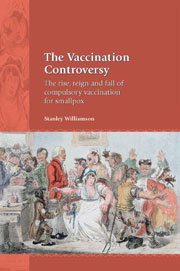Book contents
- Frontmatter
- Contents
- Acknowledgements
- Part I The Road to Compulsion
- 1 The Byzantine Operation
- 2 The Small Pockes
- 3 The Engrafted Distemper
- 4 The Language of Figures
- 5 The Suttonian System
- 6 The Great Benefactor
- 7 The Speckled Monster
- 8 The Three Bashaws
- 9 A Competent and Energetic Officer
- 10 Formidable Men
- 11 The Present Non-System
- 12 Toties Quoties
- 13 Crotchety People
- Part II The Reign of Compulsion
- Part III The Retreat from Compulsion
- Notes
- Bibliography
- Index
4 - The Language of Figures
from Part I - The Road to Compulsion
- Frontmatter
- Contents
- Acknowledgements
- Part I The Road to Compulsion
- 1 The Byzantine Operation
- 2 The Small Pockes
- 3 The Engrafted Distemper
- 4 The Language of Figures
- 5 The Suttonian System
- 6 The Great Benefactor
- 7 The Speckled Monster
- 8 The Three Bashaws
- 9 A Competent and Energetic Officer
- 10 Formidable Men
- 11 The Present Non-System
- 12 Toties Quoties
- 13 Crotchety People
- Part II The Reign of Compulsion
- Part III The Retreat from Compulsion
- Notes
- Bibliography
- Index
Summary
By the end of 1722 the mutual recriminations of the opposing parties had largely died away, chiefly for want of accurate information on which to base their contradictory claims. There was clearly a need for research, conducted at a responsible level, to establish a few reliable facts at least with regard to the success or otherwise of the operation. In December 1723, and in a slightly amended form in 1724, the Philosophical Transactions carried an advertisement:
The practice of inoculating the small pox being now extended into many parts of the Kingdom, and it being highly requisite that the public should be faithfully inform'd of the success of that method, whether good or bad: it is desir'd that all physicians, surgeons, apothecaries, and others therein concern'd will be pleas'd to transmit to Dr Jurin, Secretary to the Royal Society, a particular account specifying the name and age of every person by them inoculated, the place where it was done, the manner of the operation, whether it took effect or no, what sort of distemper it produced, on what day from inoculation the eruption appear'd, and lastly, whether the patient died or recover'd. They are desir'd to comprehend in their accounts all persons inoculated by them from the beginning of the practice among us to the end of the present year, and to send them some time in January or February next…
The results were to be made available to the public and to any gentleman, but the names of the persons inoculated would not be printed without their consent.
- Type
- Chapter
- Information
- The Vaccination ControversyThe Rise, Reign and Fall of Compulsory Vaccination for Smallpox, pp. 40 - 47Publisher: Liverpool University PressPrint publication year: 2007



